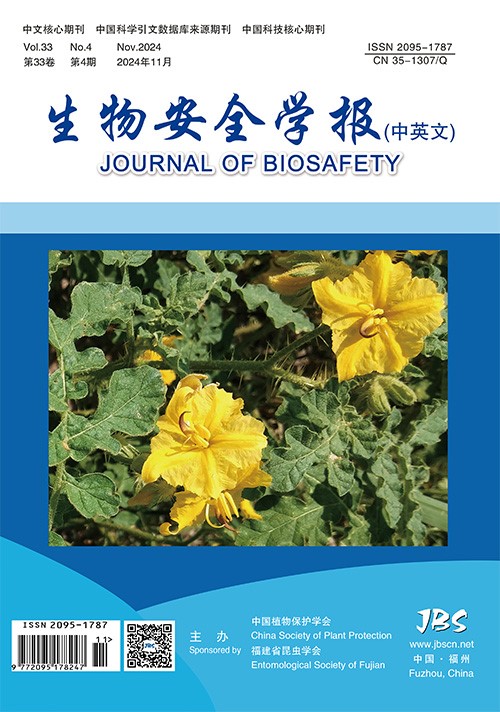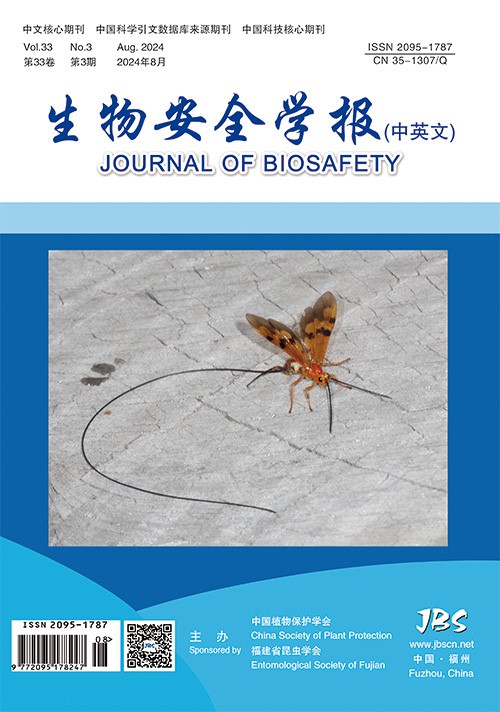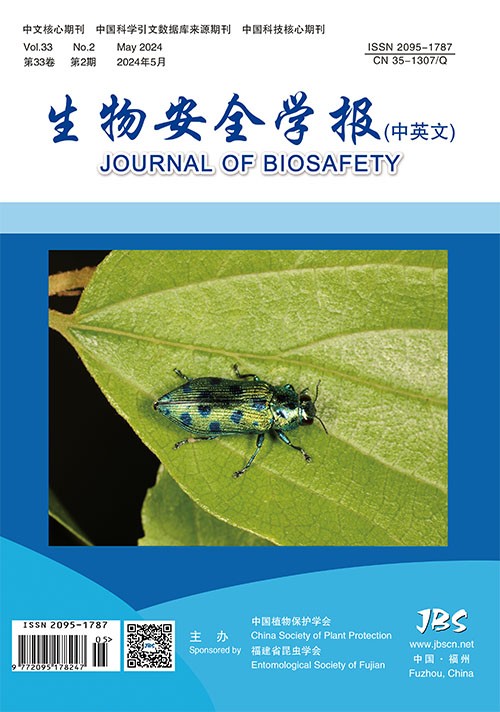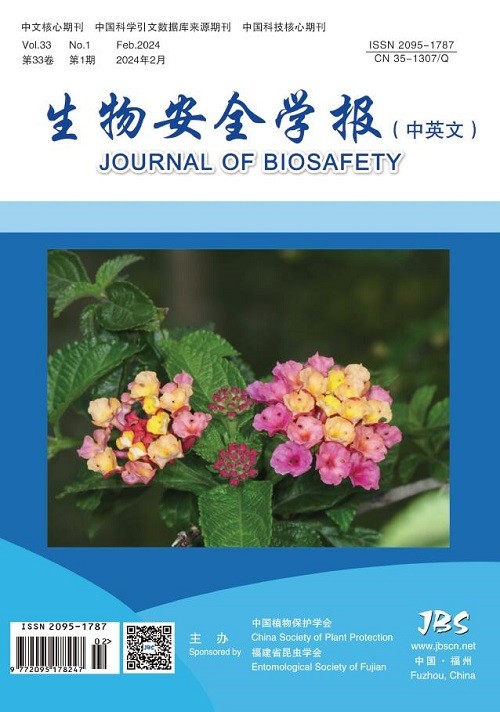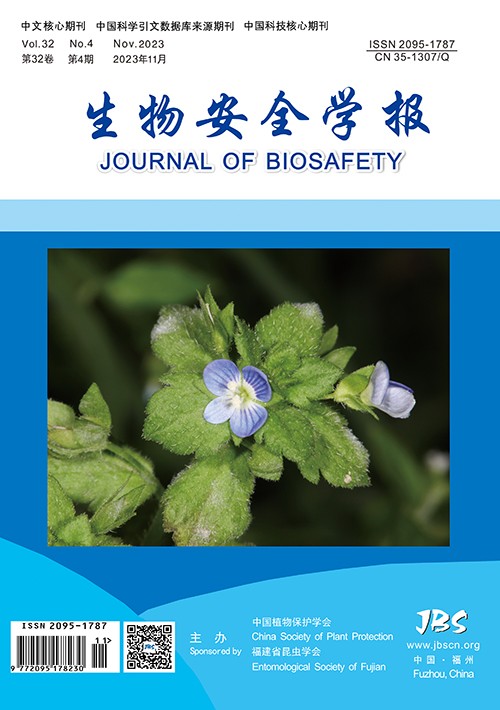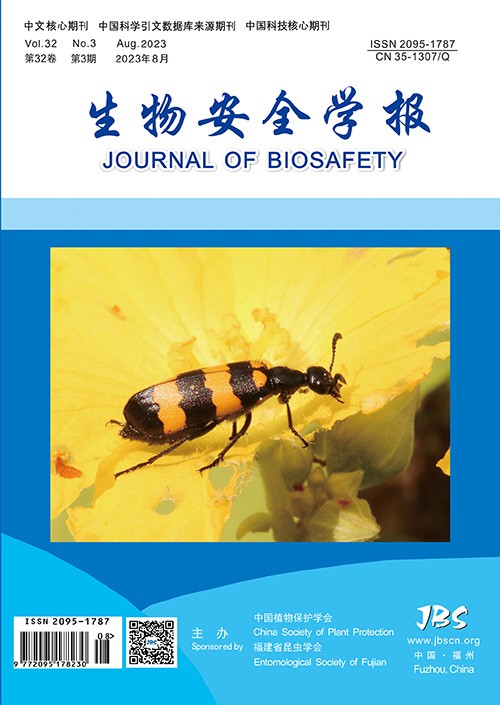 Information
Information
Governing Body:Fujian Provincial Association of Science and Technology
Organizers:China Society of Plant Protection, Fujian Entomological Society
EditingPublication:
地址:Fujian Agriculture and Forestry University, FUZHOU, FUJIAN, P R CHINA
电话:86 591 88191360
信箱:jbscn@fjau.edu.cn, jbscn@caas.net.cn
微信公众号

-
Biological characteristics and research progress in control of Sternochetus mangiferae (Fabricius) (Coleoptera: Curculionidae)
CHEN Siyu, LUO Jingjing, ZHENG Xialin, LUO Cong, HE Xinhua, WANG Xiaoyun
2025, DOI: 10.3969/j.issn.2095-1787.20240112
Abstract:
Sternochetus mangiferae (Fabricius) (Coleoptera: Curculionidae) is a major quarantine pest for mango plants, primarily transmitted through human activities. This pest imposes restrictions on the international trade of mangoes, significantly impacting the global mango industry. The present paper principally discusses the biological characteristics, distribution, invasion, quarantine, and control methods of S. mangiferae. The adult is 6-9 mm long and has a life history of approximately 40-50 days. It overwinters via dispause and deposits eggs beneath the peel. The larvae feeding on the kernel reduce the quality of the fruits and the germination rate of the seeds. The damage is concealed, and the quarantine requires recognition with the assistance of molecular detection technology. The control methods for this pest mainly include agricultural measures (such as garden clearing, pest-resistant variety breeding, and bagging), physical measures (such as radiation and microwave), chemicals (such as thiamethoxam), and biocontrol measures (such as Oecophylla and Beauveria bassiana). To mitigate the risk posed by this pest to China's mango industry, efforts should be made to strength the quarantine measures at ports, establish monitoring systems, and employ integrated measures to control the pest.
-
Advances in research on IPM for the Asian citrus psyllid (Diaphorina citri Kuwayama)
ZHOU Rui, FAN Jijun, WU Zhihong, ZHANG Xiaoping, FENG Jin, YANG Ya, ZHOU Run, HE Yanqing, TANG Zhimin
2025, DOI: 10.3969/j.issn.2095-1787.20240099
Abstract:
Huanglongbing (HLB), a devastating bacterial disease in citrus, is caused by Candidatus Liberibacter asiaticus (CLas) and has inflicted massive economic losses on the citrus industry. The Asian citrus psyllid (Diaphorina citri Kuwayama) is the major vector insect. A current method for controlling HLB is the eradication of the Asian citrus psyllid, thus interrupting the transmission of CLas. However, the long-term use of chemical pesticides has led to insect resistance, pesticide residues, mass mortality of natural enemies, and environmental pollution. Integrated pest management (IPM) can effectively control the Asian citrus psyllid while lowering the application of chemical pesticides. This paper provides an overview of the damage of HLB, the life habits of the Asian citrus psyllid, the mechanism of CLas transmission, and the dynamic monitoring and IPM of the Asian citrus psyllid, aiming to lay a foundation for the control of this insect.
-
Genetic analysis and molecular identification of Spodoptera frugiperda invading into eighteen counties in Hainan
MA Guangchang, TANG Chao, GONG Zhi, JIN Tao, WEN Haibo
2025, DOI: 10.3969/j.issn.2095-1787.20250012
Abstract:
【Aim】 Spodoptera frugiperda is a major migratory agricultural pest that is native to the tropical and subtropical regions of the Americas. Hainan is one of the source areas of this pest for migration in China. Revealing the biotypes and genetic characteristics of S. frugiperda in Hainan will be beneficial for monitoring and prevention of this pest in Hainan and even China. 【Method】 Two molecular markers, the mitochondrial gene COⅠ and the nuclear gene Tpi, were used for identification and genetic characterization of 76 samples from corn plants in Hainan. 【Result】 According to COⅠ sequences, 76.3% of samples were the rice strain and 23.7% were the corn strain. According to Tpi sequences, most samples were the corn strain, and there might be hybrids of rice and corn strains. The phylogenetic tree built based on COⅠ indicated that S. frugiperda in Hainan has the same COⅠ sequence as those in Guangdong (China), Florida (USA), and South Africa. 【Conclusion】 This study clarifies the biotypes and distribution of S. frugiperda in Hainan, providing a reference for early monitoring, warning, and precise control of this pest in Hainan.
-
Effects of flow velocity on growth and feeding of Pomacea canaliculata
WANG Miao, ZHANG Yüping, YUAN Yongda
2025, DOI: 10.3969/j.issn.2095-1787.20240065
Abstract:
【Aim】 To investigate the growth and feeding behavior of Pomacea canaliculata under different flow velocity conditions and provide guidance for P. canaliculata control in flowing water. 【Method】 Indoor simulation experiments were conducted to measure and analyze the shell height, body weight, specific growth rate, and maximum ration level of P. canaliculata under flow velocities of 3.8 cm·s-1, 7.7 cm·s-1and no flow velocity. 【Result】 The average shell height of P. canaliculata showed significant differences under different flow velocity conditions (P<0.05), while the average body weight of P. canaliculata did not show significant difference (P>0.05). Under a flow velocity of 3.8 cm/s, the shell height growth rate, body weight growth rate, and specific growth rate were higher than those under 7.7 cm·s-1and no flow velocity conditions. However, the shell height growth rate did not show a significant difference (P>0.05), while the body weight growth rate and specific growth rate showed significant difference (P<0.05). The total mortality rate of P. canaliculate under the three flow velocities was 25.6%. Specifically, the mortality rate under a flow velocity of 3.8 cm·s-1 was 30.0%, while the mortality rates under 7.7 cm·s-1 and no flow velocity conditions were both 23.3%. The mortality rates under different flow velocity conditions did not show significant differences (P>0.05). The maximum ration level of P. canaliculata under the flow velocity of 7.7 cm·s-1 was significantly higher than that under 3.8 cm·s-1 (P<0.05), while the maximum ration level under no flow velocity condition was between the two and did not show significant differences with either of them (P>0.05). 【Conclusion】 Appropriate flow velocities promote the growth of P. canaliculata, but when the flow velocity continues to increase, it restricts the growth of P. canaliculata and significantly increases the maximum ration level.
-
Identification and pathogenicity evaluation of Parastagonospora pseudonodorum in barley imported from French
YE Lufei, MOU Guiping, YAN Xiaodong, YANG Saijun, ZUO Ranling, YI Jianping
2025, DOI: 10.3969/j.issn.2095-1787.20240095
Abstract:
【Aim】 This study aims to identify Parastagonospora pseudonodorum in barley imported from French and evaluate its pathogenicity. 【Method】 A fungal isolate 5225-17 was obtained from the barley sample imported from French by the plate culture method, and it was identified based on colony morphology as well as ITS, β-tubulin, and β-xylosidase sequences. Furthermore, the pathogenicity of this isolate was tested. 【Result】 The colony of 5225-17 cultured on potato dextrose agar (PDA) appeared white flocculent in the front view and light pink in the center in the back view, with a regular margin. The isolate experienced rapid growth at a rate of 0.5~1.0 cm·d-1. It showed low sporulation on PDA and sporulation on water agar after 21 days of incubation at 20 ℃. The conidia were cylindrical, transparent, slightly curved or straight at the upper end, blunt or round at the end, with 3~5 septa, oil balls, and the average size of 26.8 μm×3.6 μm. The asci were rod-shaped, transparent, with a round top, (40~80) μm×(8~11) μm. Each ascus contained 8 ascospores, being light yellow to light yellowish brown, spindle-shaped, straight or slightly curved, obviously constricted at septa, with 3 septa, occasionally 2 or 4, and average size of 20.8 μm×4.1 μm. The ITS, β-tubulin, and β-xylosidasesequences of the isolate were identical to those of Parastagonospora pseudonodorum. The phylogenetic tree built based on multiple genes indicated that isolate 5225-17 shared the same clade with P. pseudonodorum and had a distant genetic relationship with P. nodorum. The pathogenicity test showed that isolate 5225-17 caused typical symptoms on both detached and living leaves. 【Conclusion】 The isolate 5225-17 is identified as P. pseudonodorum.
-
Isolation and identification of Burkholderia glumae causing bacterial panicle blight of rice
XIE Xuejin, ZHANG Yifan, LIU Guokun, CAI Xueqing
2025, DOI: 10.3969/j.issn.2095-1787.20240130
Abstract:
【Aim】 The pathogen causing bacterial panicle blight of rice in Xinan Village, Baizhang Town, Minqing County, Fujian Province and its biological characteristics are studied, with the aim of providing guidance for the prevention and control of this disease. 【Method】 The tissue culture method was employed to isolate the pathogen, the pathogenicity of which was then verified by Koch's postulates. The morphological characteristics, physiological and biochemical properties, and molecular evidence were used to identify the pathogen. 【Result】 Seven bacterial strains were isolated from rice samples, which were confirmed by Koch's postulates to be the pathogens of bacterial panicle blight. The bacterial strains were gram-negative, forming round and light yellow to earth yellow colonies with smooth edges on NA, KB, PDA, and CCNT plates. The strains showed optimum growth at 34 ℃ and pH7.0. The physiological and biochemical test results of the strains were consistent with those of the control strain Burkholderia glumae GX16. A single target band was obtained by amplification of Bglu3F/R, specific primers of B. glumae. Based on the results above and 16S rDNA, gyrB, and rpoD sequences, the strains were identified as B. glumae. 【Conclusion】 The pathogenic bacteria causing bacterial panicle blight of rice in Xinan Village, Baizhang Town, Minqing County, Fujian Province is B. glumae.
-
Acclimatization of Aegiceras corniculatum (L.) Blanco seedlings to simulated flooding time and salinity
WANG Hao, Lü Xiaobo, FANG Fazhi, ZENG Runjuan, ZHANG Mengwen
2025, DOI: 10.3969/j.issn.2095-1787.20240054
Abstract:
【Aim】 This study aims to investigate the variations in growth and physiological indices of Aegiceras corniculatum seedlings under different salinity and immersion time gradients. The objective is to explore the salt tolerance, immersion tolerance, and the interactive effects of salinity and immersion on seedling development. 【Method】 This study, based on simulated experiments with mangroves, utilized an automated control system in a greenhouse to simulate semi-diurnal tidal flooding. This study investigated the effects of varying salinities and flooding durations on the growth of A. corniculatum seedlings, with the aim of providing scientific guidance for mangrove restoration and achieving significant practical outcomes. The experiment included ten artificial seawater salinity (CK (0‰), S1 (5‰), S2 (10‰), S3 (15‰), S4 (20‰), S5 (25‰), S6 (30‰), S7 (35‰), S8 (40‰), and S9 (45‰)) and five flooding durations [T1 (4 h·d-1), T2 (8 h·d-1), T3 (12 h·d-1), T4 (16 h·d-1), and T5 (20 h·d-1)] gradients. Physiological and biochemical indicators, such as seedling height, basal diameter, net photosynthetic rate, catalase (CAT) and superoxide dismutase (SOD) activities, and malondialdehyde (MDA) content, were measured and analyzed. 【Result】 The findings indicate: (1) Seedlings of A. corniculatum grow best in salinity environments of 10‰-20‰, with complete mortality occurring at salinities of 40‰ and above; (2) Optimal growth occurs with flooding durations of 4-12 h·d-1, with durations exceeding 12 h·d-1 causing significant growth inhibition; and (3) The best growth is observed under a combination of 15‰ salinity and 12 h·d-1 of flooding. 【Conclusion】 The increase in basal diameter and height, as well as the net photosynthetic rate of paulownia seedlings, initially rises and then decreases with increasing salinity. With prolonged flooding, these parameters initially increased and then decreased. CAT and SOD activities, and MDA content in A. corniculatum seedlings initially decreased and then increased with extended flooding. Similarly, these parameters first decreased and then increased with higher salinity. The optimal conditions for the growth of A. corniculatum seedlings were 12 h of flooding per day and 15‰ salinity. These results provide scientific guidance for mangrove restoration.
-
Impacts of transgenic insect-resistant and herbicide-tolerant maize LP026-2 on arthropod biodiversity in the field
FAN Qianqian, YANG Shuke, LI Fan, XU Xiaohui, HAO Chaofeng, SUN Hongwei
2025, DOI: 10.3969/j.issn.2095-1787.20240094
Abstract:
【Aim】 Arthropods play a key ecological role in the field, and the impacts of transgenic crops on the diversity of arthropods are an important part of environmental safety evaluation of transgenic crops. To assess the safety of transgenic maize LP026-2, which expresses cry2Ab, cry1Fa, cry1Ab, and epsps for insect resistance and herbicide tolerance, on arthropods, we investigated the effects of LP026-2 on arthropod diversity in the field. 【Method】 The transgenic maize LP026-2 and the non-transgenic maize AX808 were planted. From day 10 post establishing to maturity, field surveys were carried out every 7 days by direct observation and pitfall trapping. The effects of LP026-2 on arthropod biodiversity were studied based on the Shannon-Wiener diversity index, Simpson index, and Pielou index. Furthermore, the effects of LP026-2 on the population dynamics of major plant-eating pests and natural enemy insects were analyzed. 【Result】 Direct observations revealed 718 and 754 individual arthropods in the LP026-2 and AX808 plots, which were categorized into 30 families belonging to 9 orders and 2 classes. Pitfall traps collected 3 057 and 3 597 individual arthropods in the LP026-2 and AX808 plots, which were categorized into 28 families belonging to 12 orders and 5 classes. No significant differences were observed in the composition and abundance of field arthropod groups. The temporal trends of the Shannon-Wiener diversity index, Simpson index, and Pielou index were broadly similar. The population size and dynamics of the major herbivorous pests (Monolepta hieroglyphica, Cicadella viridis, and Trigonotylus caelestialium) were similar between both rice types. The population size and dynamics of the major natural enemy insects (Orius similis, Chrysoperla sinica, and Propylaea japonica) did not differ between the two types. 【Conclusion】 It is initially believed that the transgenic maize LP026-2, which expresses cry2Ab, cry1Fa, cry1Ab, and epsps, had no safety risk to arthropod diversity. The findings provide key environmental safety data that can inform the regulatory decisions for the commercialization of transgenic maize LP026-2.
-
Effect of three insecticides on controlling Plutella xylostella in different areas of Fujian Province
TIAN Houjun, LIN Shuo, SUN Li, ZHU Yujing, ZHAO Jianwei
2025, DOI: 10.3969/j.issn.2095-1787.20240144
Abstract:
【Aim】 This study aims to clarify the use of insecticides in the control of Plutella xylostella in different areas of Fujian Province, understand the resistance of P. xylostella to conventional insecticides, and provide a scientific basis for the pest control of local vegetables. 【Method】 Field experiments were carried out to test the control effects of three insecticides [1.6% avermectin Bacillus thuringiensis (Bt) SC, 5% avermectin EC, 8 000 IU·μL-1 Bt SC] on P. xylostella attacking Brassica oleracea in Minhou County of Fuzhou City, Pingnan County of Ningde City, Shunchang County of Nanping City, and Zhangpu County of Zhangzhou City. 【Result】 On days 1, 3, and 7 after 1.6% avermectin Bt SC application, the control effect of low: 0.112 mL·m-2, medium: 0.15 mL·m-2, high: 0.19 mL·m-2 concentrations against DBM progressively increased with the concentration. The control effects of the three insecticides increased gradually over time. The high concentration treatment of 1.6% avermectin Bt SC demonstrated superior control efficacy compared to 5% avermectin EC. The medium concentration treatment of the 1.6% avermectin Bt SC formulation showed control efficacy equivalent to that of the 5% avermectin EC. Meanwhile, the low concentration treatment of the 1.6% avermectin Bt SC provided control efficacy comparable to that of 8 000 IU·μL-1 Bt SC. The control effects of 1.6% avermectin Bt SC at high and medium concentrations and 5% avermectin EC were significantly higher than that of 8 000 IU·μL-1 Bt SC. In general, the field control effects of the three insecticides on P. xylostella in Pingnan County and Minhou County were higher than those in Zhangpu County and Shunchang County. The three insecticides showed slow-acting properties (1 d control effect). One day after treatment, none of the three insecticides controlled P. xylostella below the economic threshold in the four counties. Seven days after treatment, all the three insecticides controlled P. xylostella below the economic threshold and had good lasting effects in Minhou County and Shunchang County. The field control effects in 7 days ranged from 77% to 89% in the four counties. 【Conclusion】 P. xylostella attacking B. oleracea has low sensitivity to avermectin, Bt, and their combination in the four counties of Fujian Province. It is suggested to use medium and high concentrations of 1.6% avermectin Bt SC in production.
-
Preliminary exploration on a risk assessment system of alien invasive plants in karst area: a case study of Zhenfeng County in Guizhou Province, China
CHEN Shuangfu, WANG Guowei, WANG Cheng, YANG Donghai, MA Yanhong, WANG Ang, XU Fangling
2025, DOI: 10.3969/j.issn.2095-1787.20240073
Abstract:
【Aim】 China is one of the largest karst regions worldwide. However, risk assessment of invasive alien plants in this region has not been conducted. This study considered Zhenfeng County in Guizhou Province as the study area to develop a risk assessment system for invasive alien plants in karst areas. 【Method】 Through field study and sample plot investigation in conjunction with literature review, the current status of invasive alien plants in karst areas was investigated. The analytic hierarchy process (AHP) was used to construct a risk assessment index system model for assessing the potential harm of invasive alien plants. 【Result】 There are 70 invasive alien plant species in Zhenfeng County, belonging to 26 families and 54 genera. The number of invasive alien plants in the family Asteraceae is the largest, followed by Leguminosae, Amaranthaceae, and Solanaceae. The risk assessment system has six first-level, 19 second-level, and 58 third-level indicators. The assessment results showed that there were two extremely dangerous plants at level Ⅰ, eight highly dangerous plants at level Ⅱ, 18 moderately dangerous plants at level Ⅲ, and 42 low-risk plants at level Ⅳ. 【Conclusion】 This study showed that there are numerous invasive alien plant species in Zhenfeng County, including ten highly dangerous plants that are widely distributed in the area. Risk assessment primarily considers the heterogeneity of karst habitats and soil and climatic conditions, which are relatively consistent with the characteristics of diversified microhabitats in these areas. Therefore, an effective risk assessment model for invasive alien plants in karst areas was developed.
-
The predation functional response of Rhynocoris fuscipes on Ostrinia furnacalis larvae
SUN Zheng, XIA Changjian, DENG Haibin, CHEN Dexin
2025, DOI: 10.3969/j.issn.2095-1787.20240086
Abstract:
【Aim】 To study the predation ability of Rhynocoris fuscipes on Ostrinia furnacalis (Asian corn borer) and provide theoretical foundation for biological control of O. furnacalis. 【Method】 Indoor experiments were designed to estimate the predation functional response, searching effect, and intra-specific interference effect of R. fuscipes in different developmental stages on larvae of O. furnacalis at different instars. 【Result】 The predatory functional response of different stages of R. fuscipes on the 2nd to 4th instar larvae of O. furnacalis belongs to the Holling II type. For the 2nd instar larvae of O. furnacalis, the predation efficiency and theoretical maximum daily predation of male adults of R. fuscipes were the highest, reaching 144.2 and 232.6 individuals. However, for the 3rd and 4th instar larvae of O. furnacalis, the female adults of R. fuscipes had the highest predation efficiency, reaching 49.1 and 67.6 individuals, 21.7 and 39.2 individuals per day, respectively. The searching effect decreased with the increase of the larval density of O. furnacalis. At the same developmental stage and density, the overall trend was female adults>male adults>5th instar nymphs>4th instar nymphs>3rd instar nymphs. The Watt model was used to fit the interference effect. The results showed that with the increase of the density of R. fuscipes, the interference effect increased, and the daily predation number of O. furnacalis larvae by single predator decreased. The female adults had the strongest self-interference effect, with a competition parameter of 0.236, while the 5th instar nymphs had the weakest self-interference effect, with a competition parameter of 0.187. 【Conclusion】 R. fuscipes exhibits a strong predatory effect on the 2nd to 4th instar larvae of O. furnacalis, demonstrating excellent potential for biological control.
-
Identification of the pathogen causing Verticillium stem striping on oilseed rape in Qinghai Province
DUAN Weijun, LIU Shuangru, YU Zilin, ZHANG Xiaomei
2025, DOI: 10.3969/j.issn.2095-1787.20240085
Abstract:
【Aim】 Verticillium stem striping of oilseed rape is an emerging disease in Qinghai Province, with symptoms including vascular bundle discoloration of roots, yellow leaves, and even plant death, seriously affecting the yield and quality of oilseed rape. Therefore, clarifying the pathogen of this disease is beneficial for oilseed rape production and disease control. 【Method】 This study isolated pathogen strains from 8 oilseed rape samples with Verticillium stem striping in Qinghai Province by the culture method. Morphological observation, DNA sequence analysis, and pathogenicity tests were carried out to identify the pathogen. 【Result】 Strain LV1314 grew slowly on potato dextrose agar. The colony turned black due to the production of a large number of microsclerotia. The strain produced verticillate conidiophores in whorls of 1-3. Conidia are hyaline and elongate, with the size of (4.50-12.88) μm×(1.91-4.82) μm and the mean length-to-width ratio of 2.81. The microsclerotia showcase the size of (22.26-194.25) μm×(7.66-48.02) μm and the length-to-width ratio ranging from 1.62 to 13.83. Neither chlamydospores nor dormant hyphae were observed. PCR sequencing was conducted for the internal transcribed spacer and actin gene. The phylogenetic analyses showed these isolates belonged to the Verticillium longisporum lineage A1/D1. The pathogenicity test showed that the pathogen infected oilseed rape and caused similar symptoms with field observation. V. longisporum was re-isolated from the discolored stem, which fulfilled Koch's postulates. 【Conclusion】 The causal agent of Verticillium stem striping on oilseed rape in Qinghai, China is V. longisporum lineage A1/D1. To our knowledge, V. longisporum lineage A1/D1 is first reported on oilseed rape in China.
-
Identification and analysis of Meloidogyne incognita lncRNAs
ZHU Zhaolu, SONG Huiying, LI Tiantian, GAO Lifen, XIAO Zilan, LI Lun, FANG Zhiwei, ZHOU Junfei, CHEN Lihong, WAN Renjing, PENG Hai
2025, DOI: 10.3969/j.issn.2095-1787.20240142
Abstract:
【Aim】 Root-knot nematodes (Meloidogyne spp.) can parasitize a wide range of economically important crops, causing significant annual agricultural economic losses in our country. Identifying and analyzing long non-coding RNAs (lncRNAs) in root-knot nematodes can lay the foundation for a deeper understanding of their gene expression regulation and parasitism mechanisms. 【Method】 High-throughput sequencing and bioinformatics analysis were employed to identify lncRNAs in Meloidogyne incognita at pre-parasitic J2 stage, parasitic J3/J4 stages, and adult female stage. Comparative analysis between the pre-parasitic and parasitic stages were conducted to determine the expression patterns of lncRNAs in M. incognita. Additionally, potential target genes of lncRNAs were predicted and subjected to functional enrichment analysis. 【Result】 A total of 655 lncRNAs were identified in M. incognita, with lengths primarily ranging from 200-1 000 nucleotides. The GC content of these lncRNAs was significantly lower than that of protein-coding genes. Differential expression analysis revealed 254 and 251 differentially expressed lncRNAs in the J3/J4 and adult female stages, respectively, compared to the pre-parasitic J2 stage. Target gene prediction identified 354 and 372 differentially expressed target genes in the J3/J4 and adult female stages, respectively. KEGG enrichment analysis of these differentially expressed target genes highlighted their involvement in processes such as the basal transcription factors, spliceosome, nucleocytoplasmic transport, and mRNA surveillance pathway. 【Conclusion】 This study provides crucial insights into the lncRNA landscape in M. incognita, elucidating their expression patterns potential functional associations with target genes. These findings lay a foundation for further investigation into the gene expression regulation and parasitic mechanisms of the M. incognita.
-
First interception of the pest species Ceratophaga tragoptila Meyrick in China
Lü Junxian, XIAO Hongpeng, LIU Zheqiang, WANG Xing, HUANG Guohua
2025, DOI: 10.3969/j.issn.2095-1787.20240139
Abstract:
A boring pest (Lepidoptera: Tineidae) was intercepted in bovine horn products imported from Nigeria at Dalian Port. The intercepted insect specimens were identified based on morphological examination via stereomicroscopy and molecular genetic analysis. The species was identified as Ceratophaga tragoptila Meyrick, marking the first interception record of this species in China. Key diagnostic characteristics distinguishing it from related species include the presence of a yellow tuft of scales on the vertex of the head; the tegumen bearing horn-shaped basal processes and the gnathos exhibiting significant terminal expansion in the male genitalia; irregularly shaped corpus bursae and the ductus bursae possessing a finger-like antevaginal plate (lamella antevaginalis) in the female genitalia. This species feeds specifically on keratin within bovine horns and can be dispersed over long distances through the trade of infested horn products, presenting a tangible risk of invasion and colonization in China. Enhanced quarantine protocols for bovine horn products imported from relevant regions are strongly recommended at all ports of entry to mitigate the risk of introduction and ensure the biosecurity of horn product transportation and storage.

 Online Submit
Online Submit Reviewing
Reviewing Edit
Edit Reader
Reader Quick search
Quick search External Links
External Links